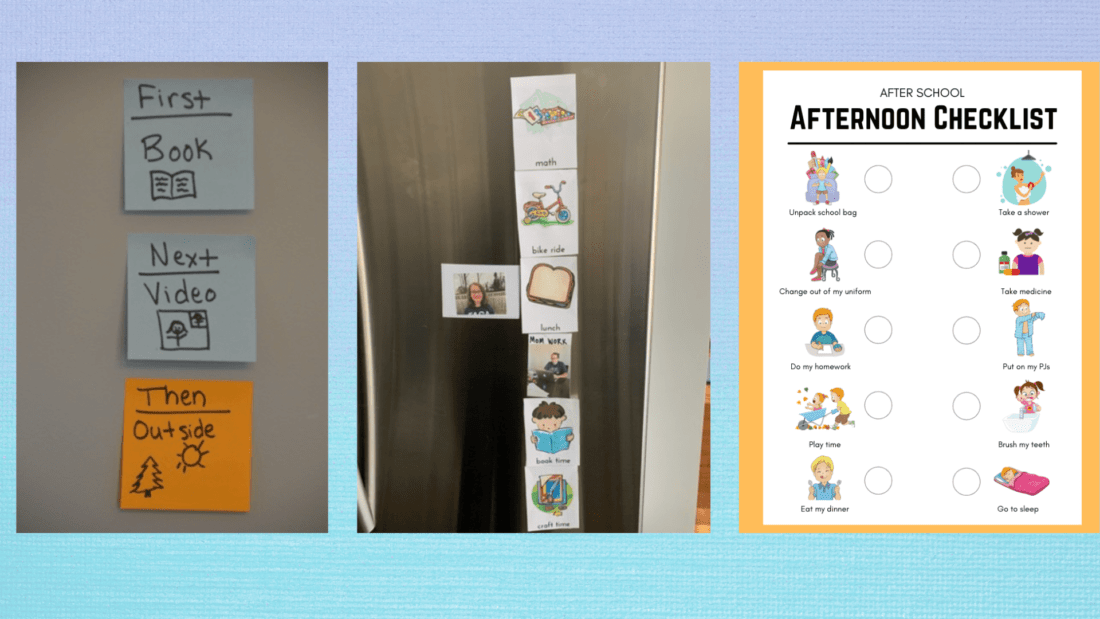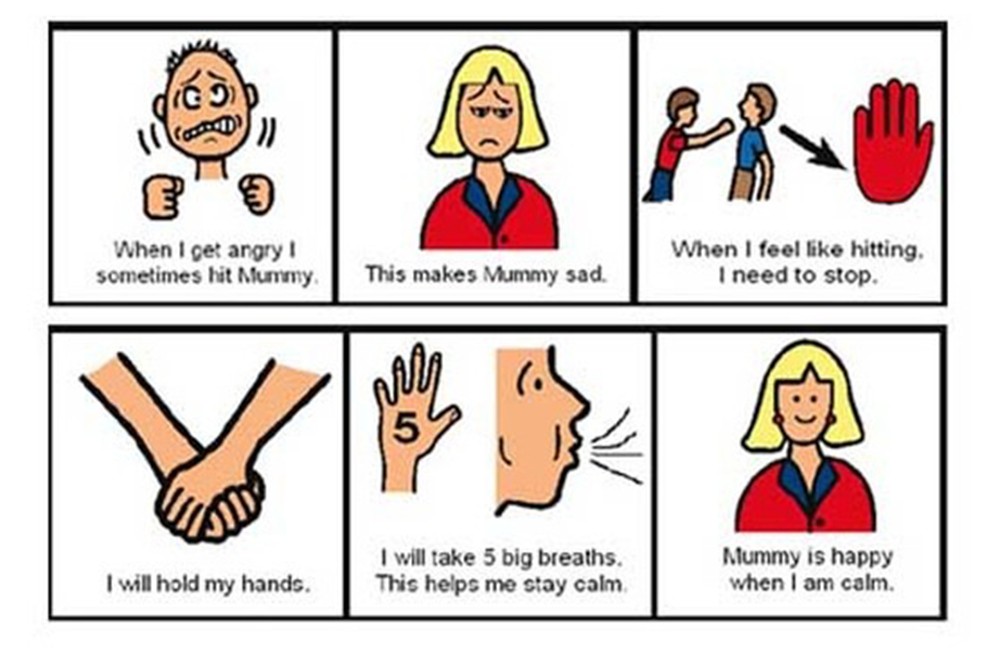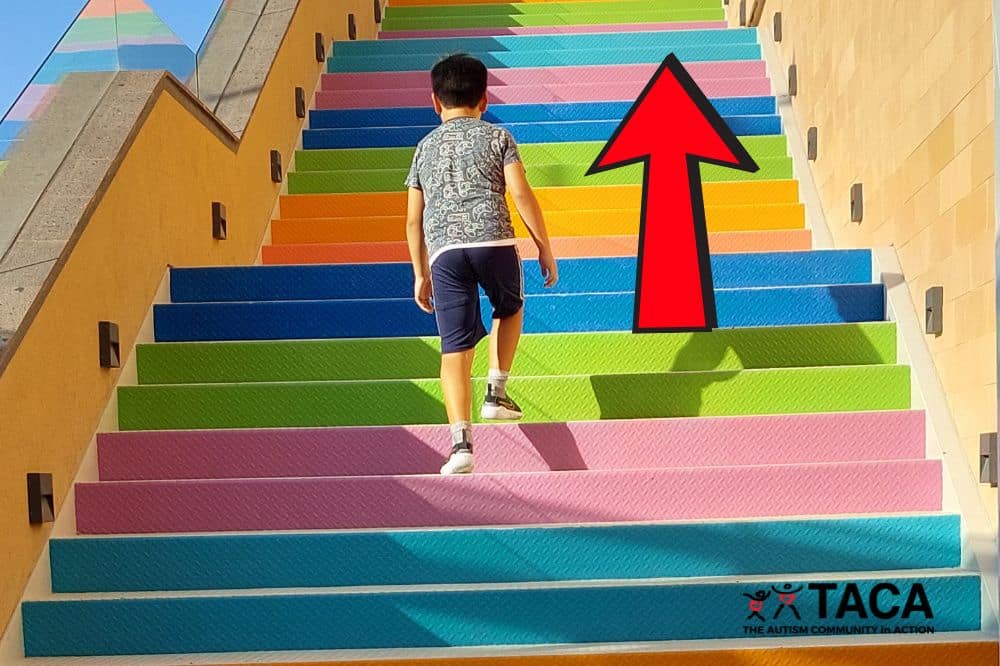Strategies for a Calmer Home

All contents of this resource were created for informational purposes only and are not intended to be a substitute for professional advice, diagnosis, or treatment. Always seek the advice of your physician, therapist, or other qualified health providers with any questions or concerns you may have.
There are numerous strategies that autism parents can incorporate into their home life that will make life easier and calmer. All it takes is a little preparation to make everything run much smoother. In addition, learning how to communicate daily happenings to your child can make all the difference. Kids with autism can meltdown with sounds that are too loud, lights that are too bright, or situations that occur without warning. Learning how to prepare for and manage these situations will make your child feel more comfortable and can make the whole family happier and healthier.
In this article, we will cover:
- Visual schedules
- Video Modeling
- Smoother transitions with timers
- Rewards and motivation
- Using Social Stories™ for new concepts
- Giving your child a way to communicate
- Avoiding meltdown triggers
- Addressing medical issues
- Simple things you can do to help calming
Visual Schedules

A visual schedule can be a beneficial strategy for your child with autism. It shows the sequence of events in pictures, so your child knows exactly what to expect, thereby alleviating anxiety and keeping them calm.
Visual schedules use the concept of “first ____, then ____,” helping the child with autism learn that there is a process to accomplishing tasks and that they are done when all items are checked off.
- Using a visual schedule to outline the day’s activities
- Your child may have a specific visual schedule for different segments of time, such as:
- Getting ready for school
- Using the toilet
- Using the shower
- Activities while at school
- Going on errands with parents
- Your child may have a specific visual schedule for different segments of time, such as:
- Use visuals to create routines
- When activities become predictable, your child will know what to expect, easing undesirable behaviors.
- Give your child a job
- Have your child check off each errand location and items bought or tasks performed at each location. This can be done with:
- An app on your mobile phone
- Paper and pencil
- Laminated pictures with velcro on the back that detach and placed in the “finished” envelope.
- Have your child check off each errand location and items bought or tasks performed at each location. This can be done with:
- Do not stray from the schedule
- Ultimately, doing this will lose your child’s trust.
- Planning thoroughly in advance is difficult but necessary.
- Fade visual lists away
- Over time, lists may be faded as your child becomes more flexible and comfortable.
- Examples of how to minimize lists are as follows:
- Change the order of the items on the list.
- Add items to the list called “free choice.”
- Move from a written, visual list to a verbal list.
Video Modeling

Watching videos of a task, activity, or desired behavior can be an excellent way for people with autism to learn new skills. With this strategy, parents can find videos online for their child to watch or you can create your own.
- Benefits of video modeling
- First, the video can be viewed as many times as needed.
- Secondly, pausing the video after each step allows you to break the task into smaller steps. This is called video prompting.
- Third, the task or behavior is shown exactly the same way and using the same narration every time.
- Types of video modeling
- Basic video modeling
- This can be a video of an actor performing a task. Otherwise, you can film a sibling, friend, or other family members.
- Self-video modeling
- Film your child performing a task. If needed, you can edit the video to show the task done correctly.
- Point-of-View video modeling
- This is when you film a task from the perspective of the person doing the activity.
- Basic video modeling
- Video Modeling Resources
- Youtube: search “video modeling” and the task you want. Example: video modeling brushing teeth, video modeling taking turns
- Model Me Kids
- Apps: iModeling, inPromptu
Smoother Transitions with Timers

Transitions can be challenging for everyone! A great strategy is using timers and warnings to let your child with autism know that one activity is ending and a new one is beginning. Paired with a visual schedule, using a timer is certainly a great tool!
- Types of Timers
- Visual timers have a contrasting coloring that creates a visually accessible way to see the time counting down. Here are a few examples:
- Effectively Using Timers
- Set the timer and let your child know they have X minutes left before the end/cleanup/next activity.
- If your child is doing a nonpreferred task, set the timer and let your child know they will be finished when the timer is finished. Start with a short time period and work your way up to a longer time period.
- Do a countdown! Tell or write down that your child has 5 minutes left, 2 minutes left, and all done.
- Consequently, this strategy works well with positive reinforcement.
Rewards and Motivation

Who is not motivated by rewards? Most adults would not work if they were not paid. The same is true for kids. Below you will find numerous strategies to make rewards work for your child.
- Use positive reinforcement
- First, use rewards to encourage the behavior that you want.
- This keeps the child-focused on what needs to be done instead of what they should not do.
- Above all, it keeps the child engaged.
- Please avoid negative reinforcement such as taking objects away with poor behavior.
- Negative reinforcement rarely works with kids on the spectrum and only serves to create more anxiety.
- Make a reward chart
- Reward charts provide a visual guide for children.
- To clarify, they should be visible and easy to understand.
- Reward charts come in many forms, including:
- The first few times you use this method, your child should earn the reward quickly so they will use it again.
- By all means, rewards do not have to be expensive. For example:
- A printed picture of something your child loves (a train, a Disney character, etc.)
- A trip to the park
- A trip to the library
- Making cookies with a parent
- Gardening time
- Watching a favorite TV show
- A sticker of a favorite character
- Playing a favorite game
- However, screen time is not recommended as a reward because it is highly addicting and can cause undesired behaviors.
- Most importantly, make the goal:
- Achievable
- Desired
- Highly motiving for your child
Using Social Stories™ and Narratives for new Concepts

Social Stories™ are a customized series of pictures and text to explain concepts and outcomes. This strategy was developed by Carol Gray. They are a way of presenting information to your child, so they can better digest the information. Social Stories™ allow your child to understand what to expect in a situation and what is expected of them.
Social Stories™ and narratives have many uses. You can use social narratives for anything you want to break down and explain to your child. For example:
- Create clear rules for house and school
- Convey what is acceptable to buy at the store
- Explain how to interact with peers
- Express abstract concepts like birth, death, friendship, and more
Social Stories™ have a specific, researched format for presenting information using at least five different sentence types. Typically, they are written in the first person.
- First, present the task of WH question
- Secondly, tell your child’s perspective, feelings, or opinion
- Then, give the directive of what you want your child to do or understand
- Next, use an affirmation
- Finally, use a conclusion sentence
- In addition, check out these sample Social Stories™
Social narratives do not follow the same prescribed layout as Social Stories™. However, you can quickly write out and tailor narratives to your child’s needs. You can make your own social narratives with a few easy steps:
- To begin with, choose a subject and outline the expectations for it.
- Then, write them down with pictures.
- After that, find pictures on google or use pictures you have taken with your phone.
- Start with images with words, then move to just words when pictures are no longer needed.
- Most importantly, present clear and simple steps.
- Read the social story with your child several times until they feel comfortable with the expectations.
There are also many places where you can buy or customize your Social Stories™ and narratives.
- Apps that allow you to create your own social stories
- Teachers-pay-teachers
- Easy Social Stories
- Carol Grey Social Stories
Lastly, you can request that your speech therapist or ABA therapist help you construct one.
Facilitate Your Child’s Ability to Communicate

Can you imagine not having a way to communicate your wants and needs? Giving your child a means to communicate can relieve frustration and improve behavior. These methods and strategies are important to consider.
- Augmentative and Alternative Communication (AAC)
- This includes all forms of communication, both low and high tech, that a person can use to communicate.
- This TACA article outlines Therapeutic and Communication Options for your child.
- Zones of Regulation
- Basically, this gives kids a visual of emotions tied to colors.
- Kids can use a Zones of Regulation chart to indicate how they feel before negative feelings escalate.
- Subsequently, this lets parents or caregivers know when to give their child a break.
- Give choices
- Empower your child by giving them reasonable choices between activities, food choices, clothing, and more.
- Be sure to use both visuals and words when offering options.
Avoiding Meltdown Triggers

Some circumstances will trigger challenging behavior in most kids, and with autism, this response is exaggerated. Below is a list of meltdown triggers to avoid.
- Hunger
- Due to the high prevalence of mitochondrial dysfunction in autism, our kids need regular meals and snacks.
- Ensure meals and snacks have enough protein and fiber to stabilize blood sugar.
- Avoid high sugar foods that will spike blood glucose, then cause poor behavior when it crashes.
- Exhaustion
- Make sure young children get regular naps
- Furthermore, stick to a consistent bedtime and establish a healthy bedtime routine.
- Overstimulating places with lots of noise, bright lights, and people
- Respecting your child’s limitations when it comes to crowds and noise can save your child from a meltdown.
- Meanwhile, keep headphones and sunglasses handy just in case there are unavoidable situations.
- Straying from routine without preparation
- Another key point is to prepare your child for new places and experiences with social stories and visual schedules, as mentioned above.
Address Medical Issues

Additionally, numerous underlying medical issues can cause challenging behavior in kids diagnosed with autism. Some of the top culprits include:
- Constipation
- Even if your child poops several times per day, this can still be an issue
- Ear Infections
- Food sensitivities
- Reactions to new medications or supplements
- PANS/PANDAS
- To clarify, this is essentially brain inflammation that causes poor behavior, anxiety, OCD, etc.
- Read more information on medical issues in autism on the TACA website.
Simple Strategies that Help with Calming

Using some of these easy strategies can help bring calm back to your home.
- Epsom Salt bath
- To begin with, most parents start with ¼ cup of plain Epsom Salt and work up to 1 cup in a warm bath.
- You can learn more about how the Epsom Salt bath works in TACA’s article on Detoxification.
- Qigong massage
- This is a massage practice that helps alleviate sensory problems.
- Teach deep breathing exercises
- Deep breathing can help your child learn to control their energy.
- Sensory Diet
- This is a tailored plan of physical and sensory activities to calm the nervous system.
- Wilbarger brushing protocol
- Similarly, this brushing protocol involves brushing the body with a small surgical brush throughout the day to calm the nervous system.
- Slow down and talk in a calm voice
- As parents, we need to model the behavior we want from our children.
- Redirection
- Additionally, it is helpful to turn your child’s attention to something new to distract them from their frustration.
- Movement (exercise)
- Likewise, exercise helps channel your child’s energy into something productive.
Conclusion
In summary, to make life easier for your child with autism, it is important to consider how they are feeling and find the best way to prepare them for situations and occurrences. As shown above, we outlined numerous strategies that should be helpful for your family and, in turn, make the home a happier, calmer, and less stressful place.




